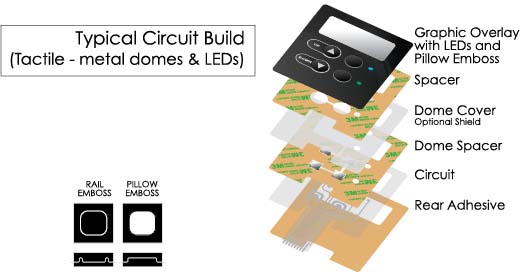Membrane Switch: Reliable, Cost-Effective, and User-Friendly Control Systems
Membrane Switch: Reliable, Cost-Effective, and User-Friendly Control Systems
Blog Article
Comprehending Membrane Switches: The Key to Resilient and Dependable Controls

What Are Membrane Buttons?
Membrane layer buttons are an innovative service in the world of interface technology, integrating capability and layout perfectly. These tools act as a user interface between customers and digital systems, incorporating several components into a small format. Normally constructed from versatile, thin layers of materials, membrane buttons are developed to reply to touch, enabling individuals to engage with equipment and digital devices effectively.
The primary aspects of a membrane button include a printed circuit layer, graphic overlay, and a spacer layer that stops unintended activation. The visuals overlay can be personalized to reflect brand identity or user choices, enhancing aesthetic appeals while guaranteeing usability. Membrane switches are commonly made use of in various applications, including clinical gadgets, customer electronic devices, and industrial tools, owing to their resilience and resistance to environmental aspects such as dampness and dust.
Among the crucial advantages of membrane layer switches is their ability to hold up against deterioration, making them optimal for high-traffic atmospheres. Furthermore, they are lightweight and need very little area, enabling for innovative layouts in item growth. Overall, membrane switches stand for a functional and reliable selection for modern-day electronic user interfaces, marrying modern technology with user-centric design principles.
Just How Membrane Layer Switches Over Job
The operation of membrane changes joints on an easy yet effective mechanism that converts customer input right into digital signals. When a customer presses the switch, the top layer deforms, allowing a conductive element in the circuit layer to make call with a matching conductive pad on the underside of the graphic overlay.
The style of membrane layer buttons can vary, but they frequently include domes or responsive elements to offer feedback to the individual, enhancing the overall experience - membrane switch. The products made use of in membrane switches, such as polyester or polycarbonate, add to their durability and resistance to environmental variables, consisting of moisture and dirt. The printed circuits are usually encapsulated, which safeguards them from wear and tear over time.
Benefits of Membrane Buttons

In addition, membrane switches are understood for their resilience. Constructed from robust materials, they are immune to dirt, moisture, and physical wear, which dramatically extends their life expectancy compared to standard mechanical buttons. This longevity makes them specifically appropriate for high-traffic environments and applications requiring durability.
An additional significant advantage is the convenience of cleaning and maintenance. The smooth surface of membrane layer switches lessens dust accumulation and is commonly unsusceptible spills, making them excellent for settings that need frequent sanitization.
Moreover, membrane layer buttons use you can find out more a structured profile, causing a thinner layout that can be integrated right into various devices without adding bulk. This function not just improves the aesthetic appeal but likewise adds to an extra ergonomic item layout.
Applications of Membrane Layer Buttons
Easy to use and functional, membrane buttons find applications across a broad range of industries, including clinical devices, customer electronics, and commercial devices. In the medical field, these switches are integral to tools such as diagnostic equipment, person tracking systems, and mixture pumps, where integrity and convenience of cleansing are crucial. Their capability to keep and withstand harsh settings capability makes them excellent for such applications.

In consumer electronic devices, membrane switches are utilized in products like microwaves, cleaning devices, and remotes - membrane switch. Their streamlined design enables user-friendly customer interfaces, enhancing the total individual experience while giving toughness and resistance to tear and put on
Industrial tools also takes advantage of membrane buttons, particularly in control panels for equipment and automation systems. These buttons offer defense pop over to these guys against dirt and dampness, guaranteeing regular efficiency in tough environments. Furthermore, their adjustable features allow suppliers to customize them to particular operational requirements, improving effectiveness and capability.
Selecting the Right Membrane Switch Over
When choosing a membrane button, it is vital to think about different variables that influence efficiency and viability for specific applications. The main factors to consider consist of environmental conditions, tactile comments, longevity, and style specifications.
First, evaluate the operating atmosphere; switches subjected to wetness, chemicals, or extreme temperatures require certain materials to make certain longevity and performance. Next, review the demand for responsive comments. Depending upon individual interaction, some applications might gain from a tactile action to validate activation, while others might favor a non-tactile style for aesthetic factors.
Sturdiness is another critical element; membrane switches must be designed to hold up against regular usage, influences, and abrasion. Make certain the chosen button can sustain the expected lifecycle, particularly in high-usage circumstances.

Verdict
To conclude, membrane layer switches over offer as necessary parts in the design of reliable and long lasting control systems across various industries. Their compact layout, integrated with durable building and construction and adjustable functions, boosts user interaction while making certain longevity in demanding atmospheres. The versatility of membrane layer switches permits tailored services that satisfy certain functional requirements, strengthening their significance in modern-day innovation. As sectors remain to progress, check my site the importance of incorporating reliable membrane switch options can not be overstated.
Membrane switches over stand for an important element of modern-day user interface design, blending capability with resilience in numerous applications.Membrane buttons are an innovative service in the world of customer interface innovation, combining functionality and style perfectly. Generally constructed from versatile, thin layers of products, membrane switches are created to react to touch, enabling users to interact with machinery and digital tools effectively.
The layout of membrane switches can differ, yet they commonly include domes or responsive components to supply responses to the customer, boosting the general experience.In final thought, membrane layer switches serve as vital elements in the design of trustworthy and sturdy control systems across numerous industries.
Report this page